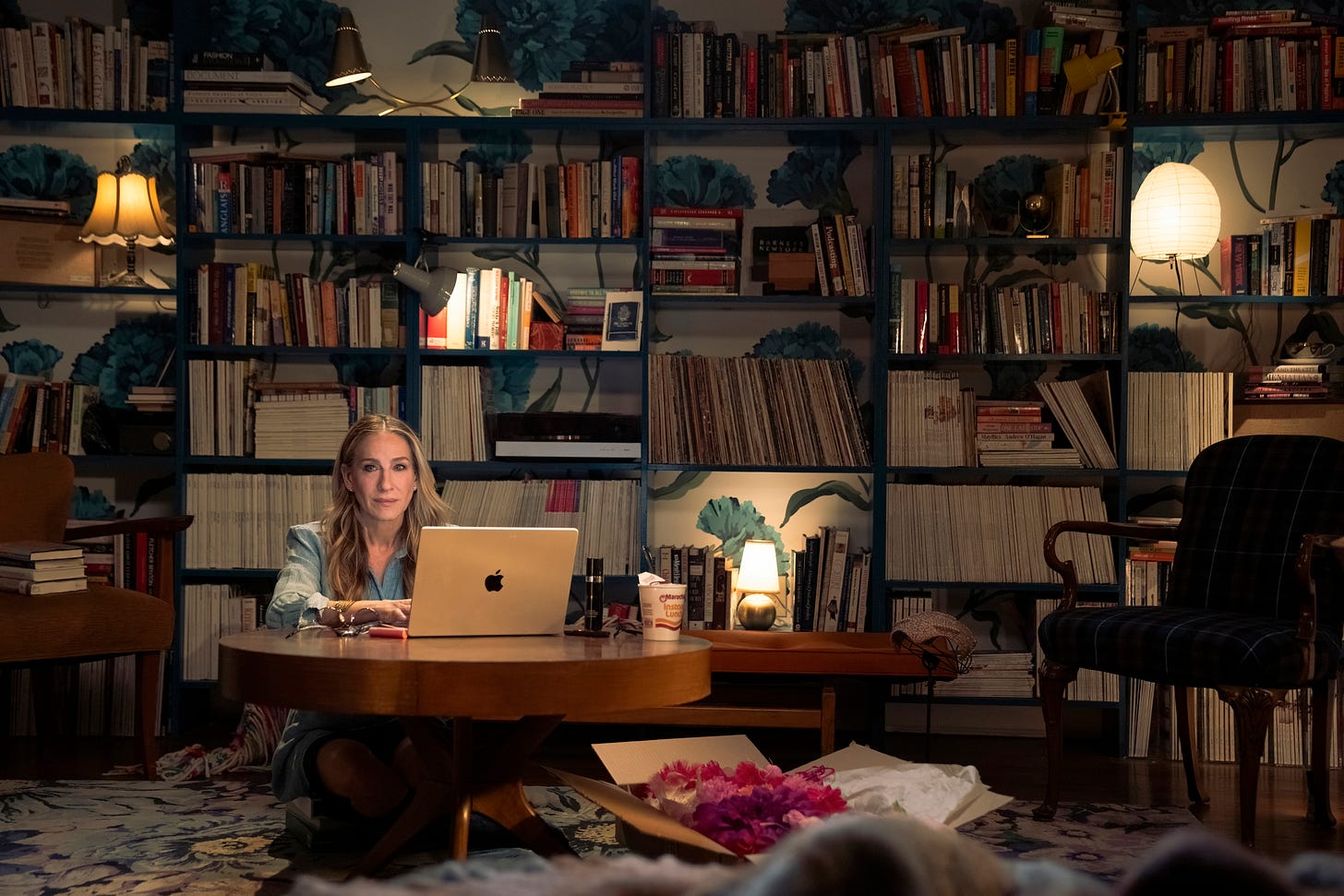'And Just Like That' Is Bad. Why Do We Like It?
I couldn't help but wonder: Why does this ill-conceived revival have us in such a chokehold?
This post was originally part of a culture series I wrote, She Was an American Gurl, but I’m recirculating it now because And Just Like That has returned for yet another extremely mid season, and it’s somehow even worse? I stand by everything I said about this show in this post, which in retrospect might have been too generous. If you think I should be entitled to financial compensation for watching this very bad show (and I think we can all agree I deserve that), you can do that here:
And if you’re reading through this wondering why does this lady care so much about Sex and the City to begin with, well, I wrote something for the debut of And Just Like That back in 2021 that should help fill the gaps.

Over the summer, I found myself in Portand, where I used to live and where, like a little aristocrat, I still travel quarterly to get my hair cut. I texted a friend of mine to tell her I was in town, and we ended up watching the newest episode of And Just Like That, projected huge on the wall of her adorable book-filled, pink-and-green-swaddled ranch-style house in the suburbs. As we drank seltzer over frozen orbs of watermelon purée, we gave what amounted to a PhD thesis defense in Sex and the City Studies to her delightful friend who was also visiting, an abortion fund employee who had never seen the show.
It was an ideal evening. But what really put it over the top was that I didn’t have to explain why I wanted to watch And Just Like That. It was understood that the world of Sex and the City had so fully sunk into our psyches that the show felt deeply good to watch, even as it arguably undoes some of the greatness of the original series, which was already pretty shredded to begin with thanks to the very silly feature films that revived the series the first time around.
I returned to my tiny house Airbnb that night seltzer-drunk and cozy, with a borrowed book about the Mr. Goodbar murders (we contain multitudes) and a full heart. And that’s one obvious explanation for why this ill-conceived revival has us in such a chokehold: It’s a source of connection and community for the generation that grew up with the original. But I still find myself confused by the seeming contradiction of how off-putting I find the show, and how much I want to watch every new episode as soon as possible. If this show so bad, why did we endure two whole seasons of it? Why will we almost certainly sit through a third?
Just like Carrie Bradshaw, I couldn’t help but wonder. And so I set out to investigate.

I began by surveying the And Just Like That fans in my life — “fans” may be a strong word here, but most of the people I talked to had watched and enjoyed Sex and the City. My deeply unscientific study includes people between the ages of 30 and 70 who will admit to having watched the Max Original (TM), a self-selecting club that, as soon as I reached out, had numerous theories as to why we just can’t quit this show, even though we know it is bad.
My friend Allie offered one compelling explanation: The low-stakes storytelling — will Carrie and Seema go on vacation? is Carrie a cat person? Stanford left but he’s actually thriving in Japan! — makes for ideal relaxation viewing.
“Blandly comforting” were the words Allie used to describe this feeling, and I can relate. I voluntarily watch plenty of upsetting shows. (Two of which — the Bachelor franchise and Yellowjackets — will be covered later on in this series.) But sometimes I want my TV viewing to be the cinematic equivalent of scooping out my brain with a melon-baller, so I can just feel kind of calm, a little dumb, and pleasantly distanced from whatever is currently adding stress to my life. And Just Like That is not a perfect show in almost any respect, but it sure is in that one!
Some of my sources even found it to be an improvement on Sex and the City in some important ways. “Even though it still seems hella tokenized, I think we need to support the bare minimum effort of including non-white cishetero representation on television, especially as reflected in the writer’s room with knock-outs like Samantha Irby,” said my former college classmate Catherine. She also appreciated the creativity of transforming Samantha into text messages, a stopgap solution to cover for Kim Cattrall’s unwillingness to reprise her role: “Can’t get your actor to come back? No worries! You can have her appear as blinking dots in text messages every other episode.”
Still, she had one chief complaint, which I share: “WHY HAVE THEY MADE MIRANDA SUCH A HELPLESS IDIOT.”
Indeed why? Of all the missteps And Just Like That has made, its retconning of sharp-edged, queer-coded, mean-but-funny Miranda into a bumbling, foolish nightmare person feels like the revival’s deepest betrayal of its source material and its fanbase. The back half of the second season has course-corrected this depiction to a degree, giving Miranda a glamorous new love interest and a job as a human rights attorney that she actually appears to be good at, which, along with Charlotte’s return to the workplace, was my favorite part of the series so far. As a soft-hearted pet person, I also genuinely loved the vet subplot. Kitten-rescuing Che Diaz is my favorite Che Diaz!
But as you can see, the highs here aren’t very high, and the critiques are numerous and valid. My original Sex and the City watch buddy, my mom, found the first season of And Just Like That almost unwatchable, in part because it depicts its 50something heroines as if they’re much older. She couldn’t be bothered to start watching the second season until long after it was over. But when she did, she was lightly but pleasantly surprised to find the ageism had been toned down somewhat, making it a show “about women who happen to be older, not about ‘older women’” with dialogue “no longer written like they’re in their 70s, not their 50s.”
As for my own qualms with the show, I find the characters’ uniform wealth to be incredibly off-putting, if for no other reason than that it lowers the already-minimal stakes of the show until they basically don’t exist.
This wasn’t true of the original series, in which Carrie was a freelance writer with an inconsistent income, who could only afford to live in Manhattan thanks to a rent-controlled apartment. She frequently mixed high fashion with $7 thrift store finds and openly discussed her money problems — some circumstantial, some due to her own poor financial planning. “I spent $40,000 on shoes and I have no place to live?” she says, horrified with herself, in an episode where her building goes co-op and she can’t afford to buy her own apartment.
The other characters in the original series had more money than Carrie, whether it came from corporate law (Miranda) or a divorce settlement (Charlotte), but the show still treated these funds as if they were finite, and framed developments like Miranda buying her first apartment as momentous rites of passage, not something to do on a Tuesday afternoon. Don’t get me wrong: No one on Sex and the City was reading Das Kapital, but the show at least treated money as something that had some bearing on the characters’ ability to live their lives as they wanted to, whether weighing the decision to have a child or applying for a loan, and these were framed as meaningful, complicated choices.
On And Just Like That, everyone is absurdly loaded. And when nothing really costs anything, literally or figuratively, it’s pretty hard to care about it.
By any of these metrics, And Just Like That is not a good TV show. But I don’t really believe in guilty pleasures, and the longevity of shows like Grey’s Anatomy (19 seasons!) and The Bachelor (28!) is solid evidence that TV doesn’t have to be critically acclaimed to be enjoyable or even meaningful to viewers. My friend Sarah, who I watched And Just Like That with in Portland last summer, even finds inspiration in the show’s mediocrity. “It makes it easier to create because watching And Just Like That miss the mark so much empowers me to do SOMETHING,” she said.
Getting to see beloved characters long after Sex and the City’s original run is like “seeing the girls in a second Saturn return,” said Sarah, and, more importantly, the show is a conduit for community, because “we get to come together each week and watch it and obsess over it, it creates for me the joy of any TV show at its best, which is talking to people about it.”
And maybe that’s what it means to love anything, whether it’s a past-its-prime TV show or the community that blossoms from it: It doesn’t have to be brilliant or perfect or tidy for us to care about it, or to give us something to talk about. It just has to exist. If you watched Sex and the City at 17, like I did, you will probably always love it, and your affection will deepen when you’re the same age as the characters in the original series. You may find the trajectory of And Just Like That deeply silly or narratively hollow, but you’ll never think twice about your Thursday night plans. And if you can share your odd obsession with like-minded people who feel the same way about this mediocre show, well, that’s just fabulous.
Epilogue
I have a confession to make. When I found out you can buy the wallpaper in Carrie’s apartment on And Just Like That — it’s designed by Sarah Jessica Parker, and its inclusion on the show is basically branded content — I ordered four panels of her design to peel ‘n’ stick on the wall behind my bed. Crouched in my sleeping loft, which cannot accommodate a person taller than me and only really accommodates me if I slouch, I sweated and swore and pushed the paper onto the wall, smoothing it into corners, tamping down air bubbles, all the while hyperaware of the fact that my neighbors could probably hear me admonishing the wall panels for their lack of cooperation. It was a laborious and frustrating task that left me with a cheerful spray of comically large, bright teal carnations behind my bed. Getting there was annoying. It was overpriced. It was even a little embarrassing. It was exactly what I wanted.
A note about this newsletter: It hits your inbox at least once a month. Burbank Industries is just me, a reproductive health policy reporter at the dawn of the theocracy. Your paid subscription makes my reporting and commentary for each newsletter possible. Thank you!
Playing you out: Cheryl Lynn’s undeniable classic “Got To Be Real” plays at a pivotal moment in Sex and the City’s fourth season, when Carrie eats shit on the catwalk at a charity fashion show, then gets up and high-fives Heidi Klum. Notably, the show uses the song in its entirety rather than cutting it, and it is glorious. I’m serious when I say this show used to be good!





